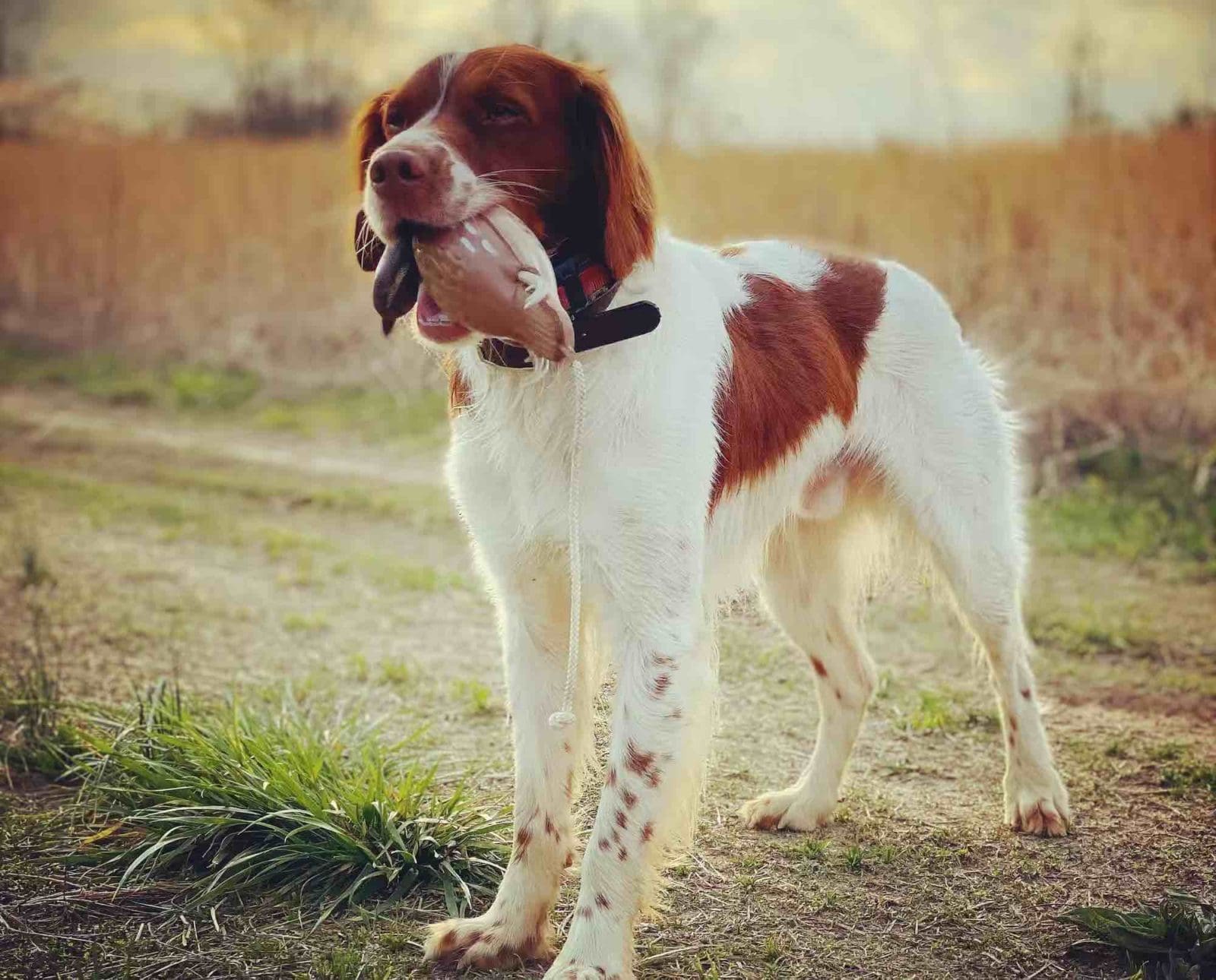Home » Hunting Dogs » Introduction to Force Fetch for Pointing Dogs
Introduction to Force Fetch for Pointing Dogs

Robb Moore has pursued the meaning of life from Tibetan…
Demystify the process of training your pointing dog to reliably retrieve any object on command
It’s not quite U.S. domestic politics or dog food, but raise the topic of “force fetch” or its euphemism, “trained retrieve,” and you’ll quickly discover that pointing dog folks have lots of feelings about it. You’ll generally find four camps: a camp of those who say they don’t need it because they don’t need their dog to retrieve but only help them find a downed bird; a “natural retrieve” camp of folks who abhor the idea and claim you don’t need to do it with a good bird dog; a camp of those who say you can’t finish a great bird dog without it and attribute to it all sorts of benefits for the handler/canine relationship; and finally a camp of those who are confused by the divide between the proponents and detractors and aren’t really sure what force fetch is. I’ll confess I’ve spent at least a little time in each of those camps before settling in as a converted proponent of force fetch, and though sometimes I need to check my evangelistic zeal and admit it might not be necessary nor even desirable for every pointing dog / handler combo, I can speak to the positive experience I’ve had with it in training Lincoln. Here I’ll make the proponent’s case for anyone who might be considering employing it with their pointing dog.
Listen to more articles on Apple | Google | Spotify | Audible
What is force fetch?
Force fetch is simply a retrieving training method in which a handler uses aversive (read: painful and/or simply uncomfortable) stimulus, most commonly an ear pinch, toe hitch, and/or e-collar stimulation, to teach a dog that it can turn off that aversive stimulus by interacting with a target object that the handler wants to teach the dog to retrieve. For those familiar with the four quadrants of operant conditioning, one could think of the method as shaping a desired behavior (retrieving) with foundational dependence on positive and negative punishment modalities. In other words, the dog learns by having an aversive stimulus applied in response to unwanted behavior and/or has aversive stimulus removed when exhibiting desired behavior.
The role of pain and/or discomfort in force fetch
Most bird dog trainers are comfortable using aversive methods to check or put the brakes on a bird dog’s innate prey drive during the steadiness process. But force fetch’s use of aversive methods not just to check powerful drives and behaviors, but to compel behavior and enhance drive in an important hunting task is part of what I think may provoke discomfort for those opposed to it.
While most of us understand that aversive methods are needed to check or rein-in such a powerful urge as prey drive in the steadiness process, some of us conceptually recoil at using pain or discomfort to compel a behavior or task we might imagine (or wish) to be as natural and innate as prey drive. Some therefore imagine force fetch to be an ineffective attempt to “push a rope,” or perhaps an unnecessary and abusive method of making the dog do something that is better left to the dog’s own desire or natural inclination. In the case of the complex task of retrieving (which, in pointing dogs, is far less innate than prey drive), force fetch does in fact give a trainer a way to compel behavior and enhance drive, in addition to reward-based incentives.
What are the benefits of force fetch?
The most striking benefit of force fetch is creating a 100% reliable retriever to a degree not otherwise possible, even with dogs with a strong innate propensity to retrieve. Beyond that, many force fetch proponents will tell you that a DIY force fetch regimen counterintuitively creates a powerful bond between the trainer and their dog. I have definitely experienced that with Lincoln – and not at all in a perverse way where the application of pain and discomfort might be imagined as a direct path to a dog’s respect for its handler. While I think alpha or pack leader theorization about dog training can be overdone and is often far too simplistic, from my own experience, I do think there is something to the idea that dogs crave strong leadership from us. The force fetch process further develops and enhances the dog’s experience of the trainer as leader.
But much more important to a dog than simple leadership is the experience of the trainer/handler as a fair and consistent leader. Dogs perhaps crave predictability most from us in knowing exactly which behaviors are desired and which are not. Force fetch provides that in spades. It allows the dog to understand its handler as a predictable, fair, and entirely consistent leader and – done correctly – force fetch provides this more cleanly and profoundly than many other bird dog training processes.
When should I force fetch my dog?
Assuming you decide to force fetch your dog, most pointing dog trainers will suggest it is best done after the dog has matured and has been fully steadied, and not prior to a pup or dog’s first hunting season. The rationale here is pretty straightforward: force fetch is both more linear and easier to achieve than steadiness on birds, but it is more likely to adversely impact the steadiness process if done first. When the force fetch process is started after steadiness has been achieved, there’s much less chance for force fetch’s use of bird-related pressure to create additional challenges for the steadiness training process. Steadiness training is often much less linear and less dependable and therefore more difficult to master for a trainer and dog than the force fetch process.
What is the full process of force fetch like?
While it’s impossible to fully detail the typical four- to six-week program here, the process typically starts on a training table (mostly to save the trainer’s back and to get the dog into a slightly unfamiliar location), with a way to secure the dog into limited mobility in the initial stages. Most will use either a hand-applied ear pinch or a toe hitch using a string that pinches two toes together, at constant pressure, while the handler simultaneously seeks to put a bumper, dowel, or other object in the dog’s mouth. As soon as the dog relents and accepts the object, the aversive stimulus is released. Over several sessions, this establishes the dog’s association that accepting the object results in a cessation of the aversive stimulus. Through a process of baby steps, this stimulus is usually transferred to an e-collar and the dog is taught over many sessions to not just accept the object, but to reach for it and take it into its mouth. Later, this action will drive the dog toward the other end of the table to pick up the object and bring it back.
All of this then has to be transferred to the ground, and extended to greater distances. With each step, the trainer has to help the dog generalize the task, often by taking a step or two back, so that the dog understands it is being asked to do the same basic thing with some small change in context (the ground vs. the table, etc.). Ultimately, the generalization must be extended to different objects by starting over at the beginning each time a new object is introduced for the carry. Most force fetch trainers will teach that you should even repeat the process from start to finish with each new object or species of bird the dog will be expected to retrieve. While the process for each new carried object goes faster and faster for the dog as it begins to generalize the overall task, this generalization training is every bit as necessary (if not more so) in force fetch as it is in all other dog training tasks.
How can I learn the force fetch method?
The basic shape of the force fetch process is very similar across different DIY bird dog training programs. While there are small variations here and there (pinch collar vs. ear pinch vs. toe hitch vs. e-collar only), I was surprised when I surveyed the various DIY programs that each offered very little in terms of innovation on the same basic program.
While finding a good and experienced mentor and/or paying for sessions with a professional trainer would always be my first recommendation for a force fetch beginner (I learned from Grayson Guyer of Lost Highway Kennels), there are also a lot of other good resources available to learn how to force fetch a dog. The Gun Dog It Yourself podcast offers a great two part discussion for those completely unfamiliar with force fetch (episodes 36 and 37), and a number of trainers detail the process for free on YouTube. Carol Ptak’s demonstration of a somewhat gentler Gibbons-West take on force fetch and the Standing Stone Kennels series on force fetch are just two great examples. There are also lots of good resources out there as a part of a larger set of training materials. George Hickox has a very good and succinct presentation of the process in Volume IV of his Training Pointing Dogs DVD Series and John Hann of Perfection Kennels does a nice job of detailing the process with previously untrained dogs in PK’s Perfect Retrieve series, which, in my view, does the best job of giving a beginner an idea of what the process is likely to look like in terms of initial dog resistance and pace of progress than shorter presentations elsewhere.
Final thoughts
If you want to take your relationship with your dog to an even higher level than you’ve already achieved, and if you like the thought of the polish and pizzazz that a perfectly consistent retrieve to hand adds to stylish and rock-solid steadiness on point, there are few better ways to achieve either goal than force fetching your dog. Just as with pointing steadiness, experiencing a fully disciplined retrieve relative to an undisciplined retrieve is akin to the difference between a relatively untrained dog flash-pointing game compared with a finished dog holding a point in high style until handler release after shot and fall.
For me and many of those in the force fetch proponent camp, it adds the final brush strokes to the artistic spectacle that is a highly refined and fully finished bird dog that enthusiastically hunts, points, and then reliably and elegantly retrieves game for its handler. It can also be one of the more obvious outward expressions of the highest caliber of relationship that a dog and handler can share together, where trust, fairness, and discipline cement an underlying mutual affection and devotion, each reinforcing the other. That’s a tall claim for a four- to six-week training process, but it’s a claim that force fetch – done well – reliably delivers to hand.
Robb Moore has pursued the meaning of life from Tibetan Buddhist monasteries in the Kathmandu valley to the ivory towers of the academy, to Christian ritual as clergy, and hospital bedsides. Recruited as a bird hunter in his mid-40s by his spunky Brittany pup, Lincoln, he is still on the hunt, but only for birds, his heart having found its rest in walking meditation and the Tao of Bird Dogs. [More musings at amanandhisbirddog.com/blog]





Force fetch trained my Brit, best thing I ever did for him. It not only made him a reliable retriever, but he really enjoyed retrieving and would retrieve anything I asked him to. Also, it seemed to make his desire to hunt stronger, and I do believe it created a stronger bond between us. He is gone now, but I will definitely force fetch train my next partner.
Wonderful to hear, Mike! I agree, can’t imagine not doing it with any future bird dog.
I LOVE the Perfection Kennel series of videos. Have followed Jon and attended multiple clinics at his place. They fixed our gunshy rescue and have helped me be a better trainer, hunter, and field trial handler.